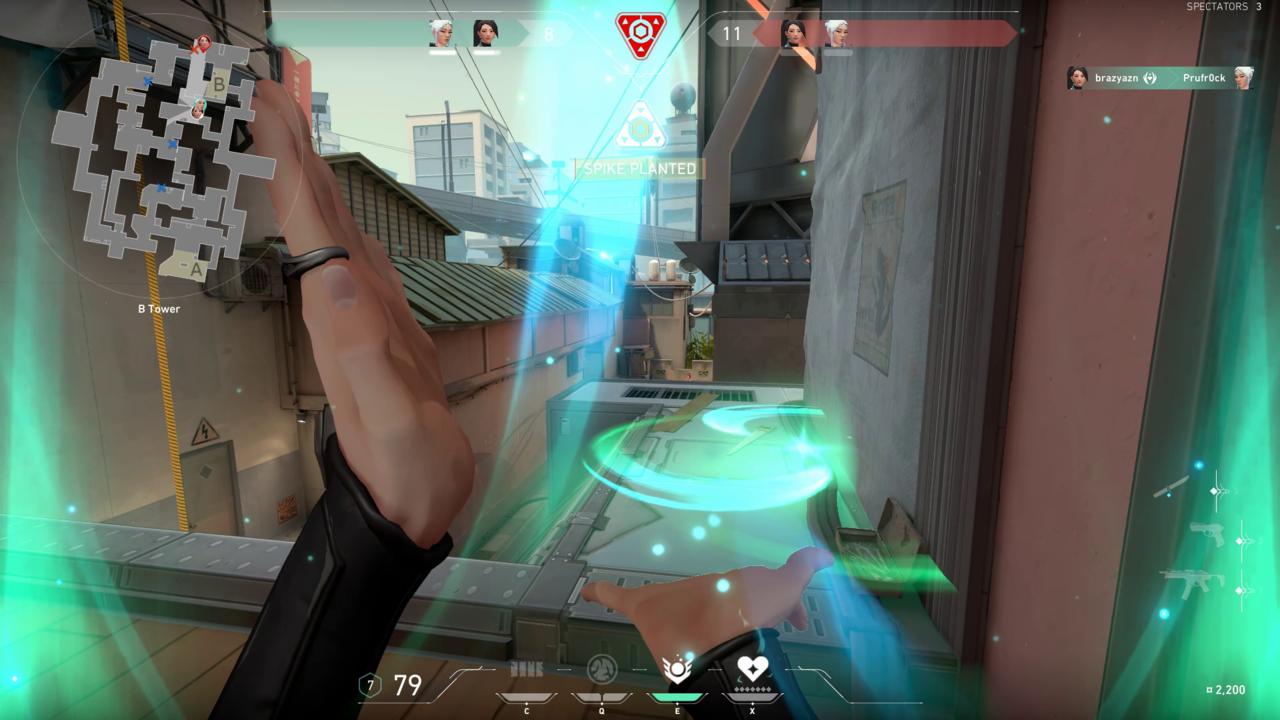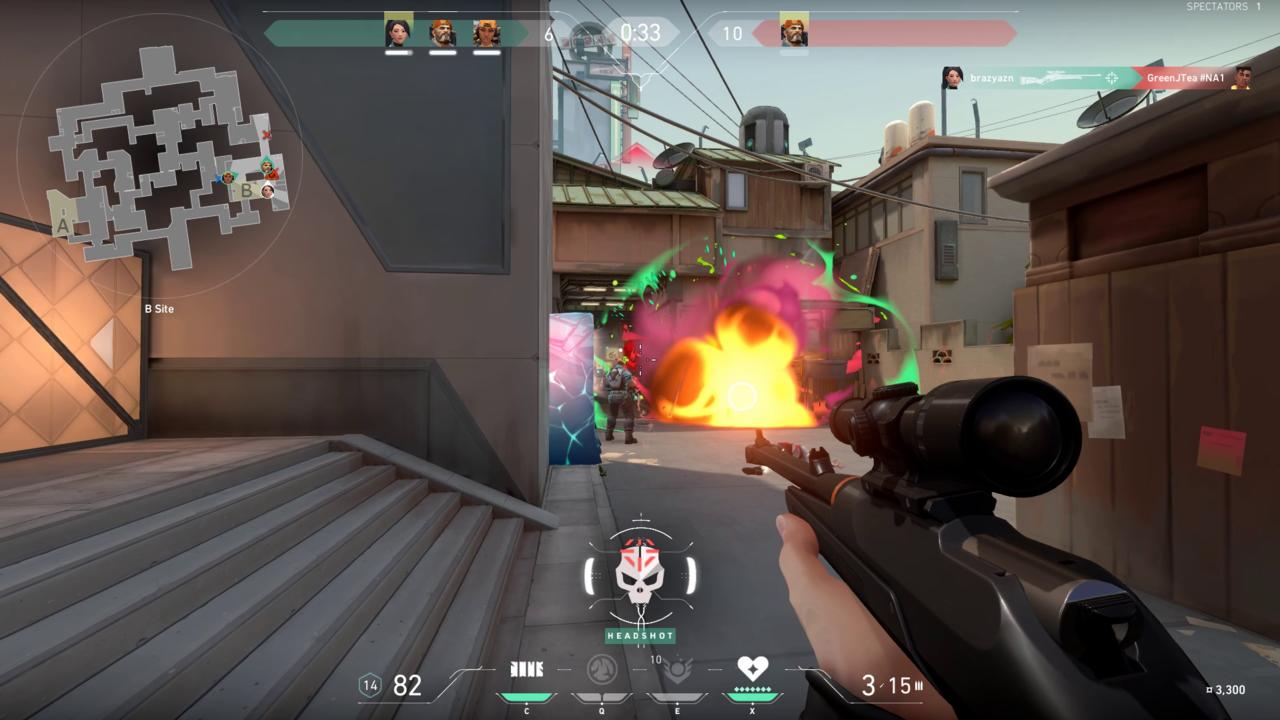Why Valorant Is The Hot New FPS
League of Legends dev Riot has released the beta for its first FPS. The CSGO and Overwatch influences are clear, which isn't a bad thing.
Valorant doesn't exactly impress on the visual front. It's quite flat from a presentation standpoint and probably won't grab you at first sight, at least from what we've seen in its closed beta. But as a veteran Counter-Strike player who's poured several hours into Valorant's beta, I'm convinced that Riot Games (developer of League of Legends) is hitting all the right notes from a gameplay perspective with its first foray into the competitive FPS genre.
At its core, Valorant is essentially a hero-shooter Counter-Strike, and borrows from CS in nearly every aspect. In a series of one-life-per-round bouts, you buy equipment at the start of each one before tactically fighting it out in a five-on-five demolition mode--one side attacks, one side defends. Even in map design, how weapons function, and the very strategies teams should implement to succeed, the influence is apparent. Hell, you even run faster with a knife equipped in place of a gun. My own skills and knowledge from years of CS have translated almost one-to-one in the Valorant beta, and I'm having a blast because of it. Even in team communication, random teammates and I have been using the identical terminology and callouts as we would in CS--long A, mid-to-B, heaven, window, and pit are a few of the shorthand terms that immediately tell me what I need to know.
Admittedly, that may sound off-putting to newcomers with little experience in this regard. There are specific ways to play CSGO, and by extension, Valorant. While it may not be the most accessible shooter because of that, the general best practices are straightforward; don't run-and-gun, watch corners where enemies are expected, and work with your team. It has a tempered pace by nature.
Now, when it comes to the Overwatch influence, Valorant's Agents are essentially heroes, all with unique abilities that feed into teamplay and strategy. These "hero elements" are also layered on intuitively without overshadowing gunplay, and seem to be balanced from my experience so far. They're fairly basic, and getting the hang of each character's moveset takes a match or two, but Agents and their powers give a welcome twist to the tried-and-true gameplay loop of CS that'll take longer to master. Sage's healing spells and methods of obstructing enemies can turn the tide, just as much as Phoenix's flashbang and self-revive Ultimate. And Viper's arsenal of poison walls and AOE spells can make your offensive pushes so much more effective. Those are the three Agents I've mainly played, of which there are 10 (five to start, five to unlock).

For some examples of these Agent powers at work: Playing as Sage, I used the Barrier wall ability to block the main sightline of the enemy spike (well, bomb) that was already planted. This allowed me to start defusing the spike without getting shot at. Although the wall was then attacked and nearly destroyed, this helped expose the enemy position, making for an easy kill followed by a safe defusal. Sage's resurrection Ultimate is huge in clutch situations. Going into a bomb site 1v2 to defuse a spike turned into a 2v2 situation, giving me backup as I secured the last two kills and an easy defusal. It's in moments like these where Agents show their potential to change up the familiar flow.
Agent abilities basically take the place of CS's grenades, because those serve a similar purpose; smokes to block sightlines, incendiaries to block paths with AOE DOTs, and flashbangs to blind enemies. Of course, the more you dig into how Agents function, the more dynamic they reveal themselves to be. When it comes to guns in Valorant, they definitely lack the sort of impact or visual feedback you would get from CS, which is disappointing. But the way in which you control their recoil and adapt to spray patterns feels right at home, especially when I'm watching corners, anticipating enemies to peek at any moment, or when I'm going head-to-head in an open firefight.
Gameplay has been sharp, smart, and tactical thus far, and the beta has at least shown that Valorant is shaping up to be the right blend of its influences.
With all that said, Valorant doesn't exactly break new ground. The fact that my experience in previous games got me up to speed immediately says a lot about its stark similarities. It's like I've seen these maps before and been through the same motions with strategies. That's not an inherently bad thing, but it sure is noticeable. It works, though, because Valorant's gameplay mechanics are tight and the layer of Agents is just enough to break it from being too familiar. Thus, the CS-style gameplay loop feels somewhat fresh while tapping into the best aspects of it, and that's why Valorant has me hooked.

A competitive shooter needs to nail the gameplay fundamentals to thrive, and Valorant is showing a lot of promise on that front. However, if it plans to stand out and have long-term appeal, Riot may want the game to be a more visually enticing one. Regardless of whether it's fair to compare it to Overwatch's flashy style or even CSGO's punchiness, that's what Valorant is going up against. The initial Agent designs show potential and have some degree of charisma that I can see being built on, but as is, it comes off as phoned-in. It's in the stiff animations, flatness of visual detail, and some cheesy (but not endearing) personalities. Map layouts are well-designed, but I don't get the same distinctiveness as I would in an Overwatch map, or even a place as ordinary as CS's Dust 2. And from a spectator's point of view, that might make it one of the less interesting competitive games to watch.
The hype is certainly there; the beta broke Twitch streaming records with 34 million hours watched in a single day and 1.7 million peak concurrent viewers. The hope is that from now until its planned Summer 2020 release, Valorant presents itself in a more exciting fashion and breathes a bit more life into its roster of Agents, especially If it hopes to tap into CS's longevity or Overwatch's prominence. Gameplay has been sharp, smart, and tactical thus far, and the beta has at least shown that Valorant is shaping up to be the right blend of its influences.
Valorant News & Announcements
- Valorant's New Agent Skye Has A Healing Ability
- More Valorant Act 3 Details Revealed
- Valorant Ranked System And Competitive Mode Explained
- + Show More Valorant News & Announcements Links (2)
- Valorant Console Release Is "Definitely" Being Prototyped
- How To Download Valorant On PC
Got a news tip or want to contact us directly? Email news@gamespot.com
Join the conversation